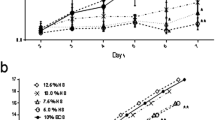Abstract
Both allogenic and autologous cultured skin cells have been used clinically on burn patients. In vitro cultivation of human keratinocytes has been routinely provided by the Central Tissue Bank in Bratislava since 1996, with an average annual production of around 7,000 cm2. Keratinocytes have been cultivated using a version of the original by Rheinwald and Green (Cell 6:317–330, 1975) methodology which has been modified over time in our laboratory as we gained more experience with this serial passage system. We have observed that the growth of cultured keratinocytes depends on several important factors, including the timing of skin sample procurement, the method of skin sample procurement, the general condition of the patient, the quality and composition of the culture media and, to a lesser extent, the age of the patient. We aim to share our experience with other cell cultivation facilities.



Similar content being viewed by others
References
Barillo DJ, Nangle ME, Farrell K (1992) Preliminary experience with cultured epidermal autograft in a comunnity hospital burn unit. J Burn Care Rehabil 13(1):158–165
Billingham RE, Medawar P (1951) Technique of free skin grafting in mammals. J Exp Bio 28:385–402
Boyce ST, Goretsky MJ, Grenhalgh DG, Kagan RJ, Rieman MT, Warden GD (1995) Comparative assessment of cultured skin substitutes and native skin autograft for treatment of full-thickness burns. Ann Surg 222(6):743–752
Brychta R, Adler J, Rihova R, Suchánek V, Komárková J (1994) Cultured skin cells for treatment of burns. Ann Medit Burns Club 71(4):206–208
Cairns BA, deSerres S, Brady L, Hultman C, Meyer A (1995) Xenogenic mouse fibroblasts persist in human cultured epidemal grafts: a possible mechanismus of graft loss. J Trauma 39(1):75–79 discussion 79–80
Chester DL, Balderson DS, Papini RP (2004) A review of keratinocyte delivery to the wound bed. J Burn Care Rehabil 25(3):266–275
Compton CC, Gill JM, Bradford DA, Regauer S, Gallico GG, O’Connor NE (1989) Skin regenerated from cultured elithelial autografts on full thickness wounds from 6 days to 5 years after grafting. Lab Invest 60(5):600–612
Damodaran G, Syed M, Leigh I, Myers S, Navsaria H (2008) Clinical application of skin substitutes. Expert Rev Dermatol 3(3):345–356
Dragúňová J, Panáková E, Koller J (2002) Cultivation of human keratinocytes in the CTB Ruzinov. In: 11th international conference on tissue banking and EATB. Annual meeting Oct 23–26 Bratislava, Slovakia, p 43
Green H, Kehinde O, Thomas J (1979) Growth of human epidermal cells into multiple epithelia suitable for grafting. PNAS 76(11):5665–5668
Grossman N, Slovik Y, Bodner L (2004) Efect of donor age on cultivation of human oral musocal keratinocytes. Arch Gerontol Geriatr 38(2):114–122
Hafemann B, Frese C, Kistler D, Hettich R (1989) Intermingled skin grafts with in vitro cultured keratinocytes-experiments with rats. Burns 15(4):233–238
Harris PA, Leigh IM, Navsaria HA (1998) Pre-confluent keratinocyte grafting: the future for cultured skin replacements? Burns 24(7):642–645
Herndon DN, Rutan RL (1992) Comparison of cultured epidermal autograft and massive excision with serial autografting plus homograft overlay. J Burn Care Rehabil 13(1):154–157
Hickerson WL, Compton C, Fletchall S, Smith LR (1994) Cultured epidermal autografts and allodermis combination for permanent burn wound coverage. Burns 20(Suppl 1):52–56 discussion S55–S56
Johnson M, Meyer AA, deSerres S, Herzog S, Peterson H (1990) Persistence of fetal bovine serum in human keratinocytes. J Burn Care Rehabil 11(6):504–509
Karasek M (1966) In vitro culture of human skin epithelial cells. J Invest Dermatol 47:533–540
Khodadadi L, Shafieyan S, Aghdami N, Baharvand H (2008) Cell therapy in Burn repair. Yakhteh Med J 10(3):167–178
Kwang HL (2000) Tissue-engineered human living skin substitutes: development and clinical application. Yonsei Med J 41(6):774–779
Ljunggren CA (1898) Von Fähigkeit des Hautepithels ausserhalb des Organismus sein Leben zu behalten mit Beruchsichtigung der Transplantation. Deutsche Zeitschrift fur Chirurgie 47:608–615
Munster AM, Weiner SH, Spence RJ (1990) Cultured epidermis for the coverage of massive burn wounds. Ann Surg 211(6):676–680
O′Connor NE, Mulliken JB, Banks-Schlegel S, Kehinde O, Green H (1981) Grafting of burns with cultured epithelium prepared from autologous epidermal cells. Lancet 317:75–78
Odessey R (1992) Addendum: multicenter experience with cultured epidermal autograft for treatment of burns. J Burn Care Rehabil 13(1):174
Putland M, Snelling CF, Macdonald I, Tron VA (1995) Histologic comparison of cultured epithelial autograft and meshed expanded split thickness skin graft. J Burn Care Rehabil 16(6):627–640
Rheinwald JG, Green H (1975) Formation of a keratinizing epithelium in culture by a cloned cells line derived from a teratoma. Cell 6:317–330
Rheinwald JG, Green H (1979) Serial cultivation of strains of human epidermal keratinocytes : the formation of keratinizing colonies from single cells. Cell 6:331–344
Author information
Authors and Affiliations
Corresponding author
Rights and permissions
About this article
Cite this article
Dragúňová, J., Kabát, P., Koller, J. et al. Experience gained during the long term cultivation of keratinocytes for treatment of burns patients. Cell Tissue Bank 13, 471–478 (2012). https://doi.org/10.1007/s10561-011-9275-z
Received:
Accepted:
Published:
Issue Date:
DOI: https://doi.org/10.1007/s10561-011-9275-z




